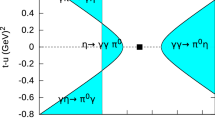Summary
The mechanism for the rare radiative decay mode K 01 →2γ is treated as the virtual disassociation of K 01 into a π+π− pair followed by internal annihilation of the pions into photons. Introducing a direct K 01 -2π interaction and using the techniques of dispersion theory, the branching ratioΓ(K 01 →2γ)/Γ(K 01 →π+π−) is expressed in terms of theI=0,s-wave pion-pion scattering phase shifts. With negative and small positive π-π scattering lengths, numerical estimates indicate no appreciable enhancement of the branching ratio from its perturbation-theory value: 0.24·10−5. Branching ratios of the order of 10−4 to 10−3 are obtained for large positive scattering lengths provided that the high-energy behaviour of the phase shifts has a specified character.
Riassunto
Si tratta il meccanismo del raro modo di decadimento radiativo K 01 2→γ come una dissociazione virtuale del K 01 in una coppia π+π− seguita da annichilazione interna dei pioni in fotoni. Introducendo un’interazione diretta K 01 -2π e facendo uso delle tecniche della teoria della dispersione, si esprime il rapporto di suddivisioneΓ(K 01 →2γ)/Γ(K 01 →π+π−) in funzione degli spostamenti di fase dello scattering pione-pione in ondas, conI=0. Per lunghezze dello scattering π-π negative e positive piccole, le stime numeriche indicano che non si ha un apprezzabile aumento del rapporto di suddivisione rispetto al suo valore in teoria delle perturbazioni: 0.24·10−5. Per grandi lunghezze di scattering positive si ottengono rapporti di suddivisione dell’ordine di 10−4 a 10−3, purchè il comportamento degli spostamenti di fase abbia alle alte energie un carattere specifico.
Similar content being viewed by others
References
M. Cabbibo andE. Ferrari:Nuovo Cimento,18, 928 (1960).
J. Dreitlein andH. Primakoff:Phys. Rev.,124, 268 (1961).
J. L. Brown, J. A. Kadyk, G. H. Trilling, B. P. Roe, D. Sinclair andJ. C. Vander Velde:Phys. Rev.,130, 769 (1963).
M. L. Goldberger andS. B. Treiman:Nuovo Cimento,9, 451 (1958).
V. Barger andE. Kazes:Phys. Rev.,124, 279 (1961);Nuovo Cimento,28, 394 (1963).
M. Gourdin andA. Martin:Nuovo Cimento,17, 224 (1960).
B. Desai:Phys. Rev.,124, 1248 (1961).
S. Mandelstam:Phys. Rev.,112, 1344 (1958);115, 1741, 1752 (1959).
W. R. Frazer andJ. R. Fulco:Phys. Rev.,119, 1420 (1961).
J. Dreitlein andB. W. Lee:Phys. Rev.,124, 1274 (1961). These authors derive a somewhat similar result in calculating the lifetime of Σ0.
This is due to gauge invariance. The authors of ref. (1) failed to obtain this cancellation in a perturbation theory calculation.
R. F. Sawyer andK. C. Wali:Phys. Rev.,119, 1429 (1960).
T. N. Truong:Phys. Rev. Lett.,6, 308 (1961).
N. E. Booth, A. Abashian andK. M. Crowe:Phys. Rev. Lett.,7, 35 (1961)
B. R. Desai:Phys. Rev. Lett.,6, 497 (1961).
D. Atkinson:Phys. Rev.,128, 1908 (1962).
R. H. Capps:Phys. Rev.,128, 2842 (1962). In this article it is conjectured that the real parts of the low-angular-momentum phase shifts approach ±π/2 at high energies. We note thatδ(∞)=π/2 is consistent with our requirements.
S. K. Bose:Phys. Lett.,2, 92 (1962).
Experimental value of the K 01 –K 02 mass difference isτ(K 01 )|ΔM| =1.5±0.2.U. Camerini, W. F. Fry, J. A. Gaidos, H. Huzita, S. V. Natali, R. B. Willmann, R. W. Birge, R. P. Ely, W. M. Powell andH. S. White:Phys. Rev.,128, 362 (1962).
W. F. Fry: (private communication).
Author information
Authors and Affiliations
Additional information
Work supported in part by the U. S. Atomic Energy Commission.
Rights and permissions
About this article
Cite this article
Barger, V. K 01 →γ+γ decay mode. Nuovo Cim 32, 127–135 (1964). https://doi.org/10.1007/BF02732596
Received:
Published:
Issue Date:
DOI: https://doi.org/10.1007/BF02732596




